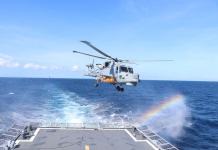As tensions between Australia and China increases, Aussie PM Scott Morrison has announced a 40% boost over the next 10 years to its defence budget focusing on the Indo-Pacific region.
According to experts, this muscle posturing by Canberra is to counter the growing Chinese influence in the Indo-Pacific region.
Chinese Military Base In The Pacific Near Australia Could Be A Nightmare For The US & Allies
“We want an Indo-Pacific (region) free from coercion and hegemony. We want a region where all countries, large and small, can engage freely with each other and be guided by international rules and norms,” said Morrison in a speech in Canberra.
He also stated that Australia will now spend A$270 billion ($186.5 billion) over the next 10 years to acquire longer-range strike capabilities across air, sea and land.
This is expected to further inflame tensions with China. “While it’s absolutely right that we focus on our region, but buying long-range missiles – particularly ones for land targets – could invite a response from Beijing,” said Sam Roggeveen, director of the Sydney-based Lowy Institute’s International Security Program.
How Pakistan-Backed Azerbaijan Is Confronting India-Backed Armenia?
The bilateral ties between the two nations soured and tensions increased when Australia banned the Chinese telecommunication giant Huawei for its 5G services for security concerns. Beijing was also miffed when Canberra demanded an independent inquiry into the origins of Covid-19.
Recently, PM Scott Morrison said that Australia was under increasing cyberattack from a “sophisticated state-based cyber actor,” pointing towards China trying to hack all levels of the government, political bodies, essential service providers and operators of critical infrastructure.
As reported by EurAsian Times, Beijing has accused Australia of escalating the conflict and “waging an intensifying espionage offensive against China”. Chinese Foreign Ministry spokesman Zhao Lijian said that Australia is sending agents to China to spy, gather intelligence, recruit assets and instigating defection among Chinese nationals.
With rising Australia-China tensions, the decision to boost defence spending is seen as Canberra’s intention to be more assertive with Beijing and less reliant over the United States.
“Tensions over territorial claims are rising across the Indo-Pacific region – as we have seen recently on the disputed border between India and China, in the South China Sea, and in the East China Sea,” said Morrison. “The risk of miscalculation – and even conflict – is heightening,” he added.
According to Ashley Townshend, the director of foreign policy and defence at the United States Studies Centre, the University of Sydney, prioritising the Indo-Pacific as the focus for Australia’s defence activities is the simplest but most important policy shift.
“Since 2001, Australia has spent over $15bn on military operations in the Middle East compared to less than $4bn in our region – an unstrategic use of resources that was compounded by the way that counterinsurgency operations also warped our procurement priorities,” he explained.
He further said that this will now end, freeing up additional funds and bandwidth to support Pacific and Southeast Asian partners to better defend the strategic interests by pushing back against Chinese coercion, expansion and regional adventurism.
India-China Agree To De-Escalate Border Conflict While PLA Deploys Additional Troops Near LAC
On the other hand, Brendan Thomas-Noone, a research fellow of foreign policy and defence at the United States Studies Centre, the University of Sydney said that these new capabilities and investments – while needed – may miss the broader picture.
“With many new technologies originating in the private sector or through Australian universities having national security implications, investing and building our broader scientific and innovation capacity will be just as critical as new missiles and drones in withstanding the worsening strategic environment,” he said.




